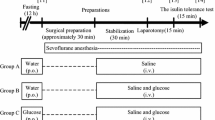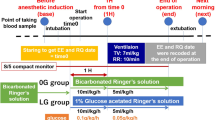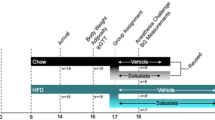Abstract
Purpose. We attempted to identify the optimal infusion rate of glucose to maintain an appropriate usage of energy sources during minor surgery after an overnight fast.
Methods. Forty patients scheduled for tympanoplasty or skin grafting under sevoflurane anesthesia were assigned to four groups. The patients received a 2-h infusion of either saline or glucose at a rate of 0.1, 0.2, or 0.3 g·kg−1·h−1. Blood samples were collected before the induction of anesthesia, and at 1 and 2 h after the start of the saline or glucose infusion. Plasma glucose, free fatty acid, β-hydroxybutyrate, acetoacetate, and immunoreactive insulin were measured.
Results. Plasma glucose concentration increased dose-dependently. Immunoreactive insulin levels increased in the groups receiving 0.2 or 0.3 g·kg−1·h−1 of glucose infusion. Free fatty acid and ketone bodies did not increase in any glucose infusion groups. The arterial ketone body ratio increased to over 1.00 in the groups receiving 0.2 or 0.3 g·kg−1·h−1 of glucose infusion. Glycorrhea was observed only in the group receiving 0.3 g·kg−1·h−1 of glucose.
Conclusion. The smaller doses of glucose (0.1–0.2 g·kg−1·h−1) prevented lipolysis and hyperglycemia during minor surgery.
Similar content being viewed by others
Author information
Authors and Affiliations
Additional information
Received for publication on March 17, 1999; accepted on September 22, 1999
About this article
Cite this article
Terajima, K., Ogawa, R. What is the optimal dose of glucose administration during minor surgery under sevoflurane anesthesia?. J Anesth 14, 14–18 (2000). https://doi.org/10.1007/s005400050003
Issue Date:
DOI: https://doi.org/10.1007/s005400050003




